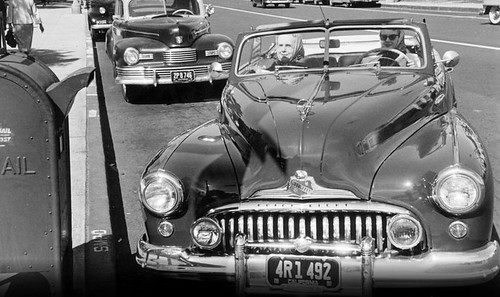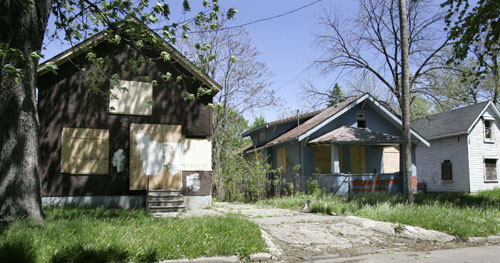Is the only option for a thinking person to go crazy when mulling over U.S. "urban" policy?

A Buick Roadmaster in California, some time in the 1950s. Photographer unknown.
The media is still full of reaction to the Flint, Michigan-induced proposal that apparently the Obama Administration is mulling over for tearing down parts of declining cities. See "Bulldoze the 'burbs?" from the Christian Science Monitor, the AP story "Fire moves into houses abandoned by foreclosures," and this good opinion piece from the Los Angeles Times, "Bulldozing our cities may wreck our future," by Gregory Rodriguez.
The issue is what do you do with urban policy, when most development, planning, and financing policies favor suburbs over center cities?
And what do you do with urban policy, when regions are shrinking in population?
These are different questions. The question for Flint Michigan, which has been decimated by the slow shrinking of General Motors over the past 35 years, is fundamentally much different from cities in regions that are growing in population.
For example, Baltimore's problem is partly a loss of manufacturing jobs, but at the same time, Baltimore is part of an expanding metropolitan region, one with reasonably high household income and a growing economy. But various state, federal, and business policies favor suburbanization and continued sprawl.
Even the whole "cash for clunkers" fiasco (see "US posts cash-for-clunkers Web site" from the Detroit Free Press) is an example of a policy that favors suburban and exurban locations over urban/center city locations that benefit not from automobile-centric policies, but from mobility policies focused around walking, bicycling, and especially transit.
It is a terrible waste of precious public financing resources to encourage automobile buying.
Flint, like many cities in the midwest, is screwed because of its monoculture economy being overly tied to the fortunes of one particular company unable to compete in a changing world.
Maybe there, shrinkage is a reasonable policy. Even so, it probably makes more sense to direct population and services toward the center city, and away from further out, exurban locations.
In any case, it doesn't make sense to extend the shrinkage concept (pioneered by Youngstown, Ohio) to growing metropolitan regions.
If the Obama Administration is considering applying such a policy without a great deal of nuance, then there is no future for urban policy in this country.

Three abandoned homes are boarded up along Jane Ave. in this East Side neighborhood of Flint, Mich. (AP Photo/Carlos Osorio).
In my neighborhood in Manor Park, in the upper northwest quadrant of Washington, DC, depending on lot size, these houses would be worth betwen $275,000 and $300,000. In Flint, they are likely worth less than $50,000.
Labels: car culture and automobility, electoral politics and influence, Growth Machine, progressive urban political agenda, smart growth vs. smarter sprawl, urban revitalization



0 Comments:
Post a Comment
<< Home